Levi’s jeans are some of the most popular in the world and can be found in almost all major apparel retailers. The company was founded in America, but many people wonder if the company still manufactures its jeans in the USA after all these years.
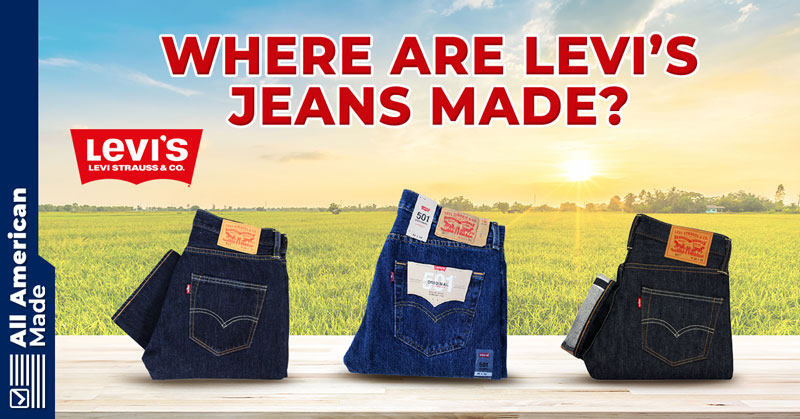
In the rest of this article, we’ll share exactly where Levi jeans are made and share other important information about the company.
Levi Jeans are made in many countries, including Pakistan, Mexico, Bangladesh, Egypt, Africa, China, India, Indonesia, and other developing countries. In the past, some Levi’s jeans were made in the USA, but almost all of their jeans are made overseas.
Unfortunately, Levi’s does not have factories in the USA. They’re a global label looking to supply an enormous demand for their products. Keeping their manufacturing in the United States isn’t a sound economical choice since they prefer to work with cheaper labor elsewhere.
To understand the scale of their production, we must mention that they usually have multiple manufacturing locations in one country. Here’s a list of the countries that house their midsize to their biggest manufacturing plants:
- Bangladesh
- China
- Egypt
- El Salvador
- Ethiopia
- Honduras
- India
- Kenya
- Lesotho
- Madagascar
- Malaysia
- Mexico
- Nicaragua
- Pakistan
- Siri Lanka
- Turkey
- Vietnam
I actually decided to head into some local department stores, including Kohls, JCPenny, and others, to see where the jeans currently on the shelves were made. Here are some photos of the labels I found on the jeans.
The first pair of Levi’s jeans that I checked was made in Lesotho, which is a country in South Africa.
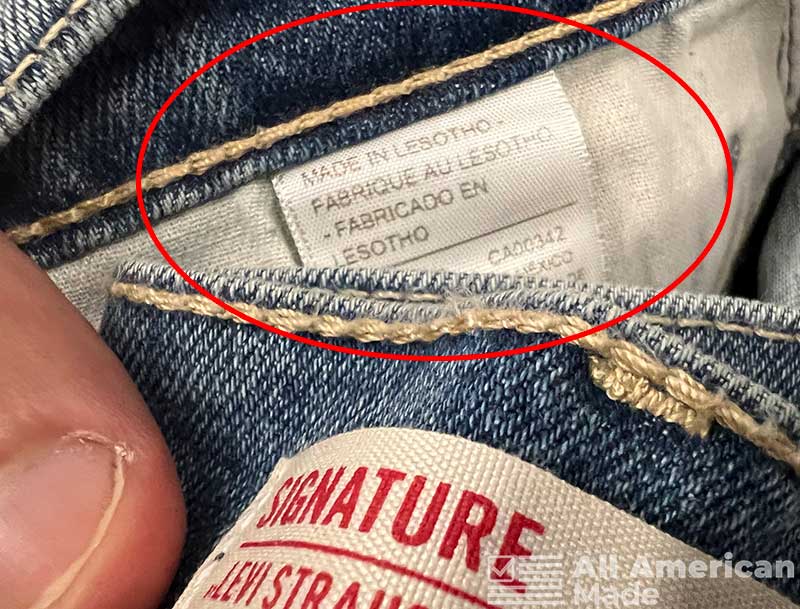
The next pair of Levi Strauss jeans I checked was made in Bangladesh, which is a country in South Asia.
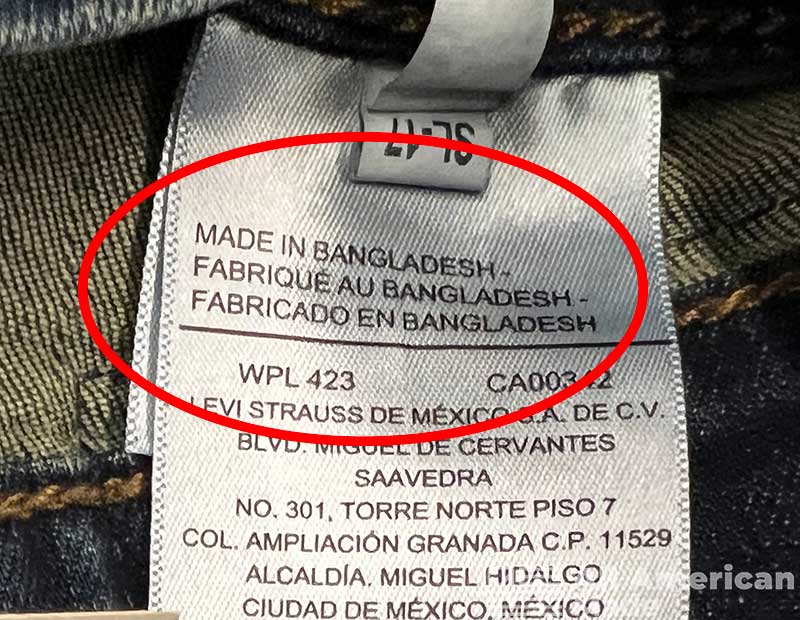
The third pair of Levi’s I checked was made in Pakistan.
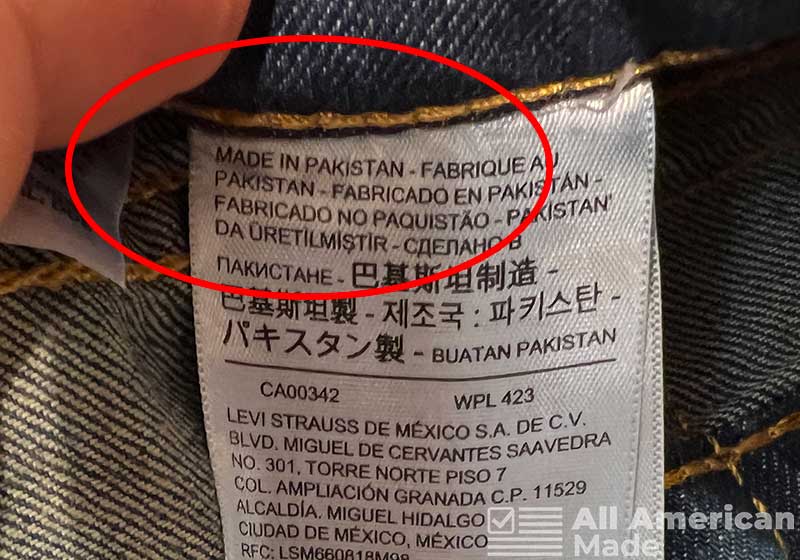
The fourth pair I checked was made in Mexico.
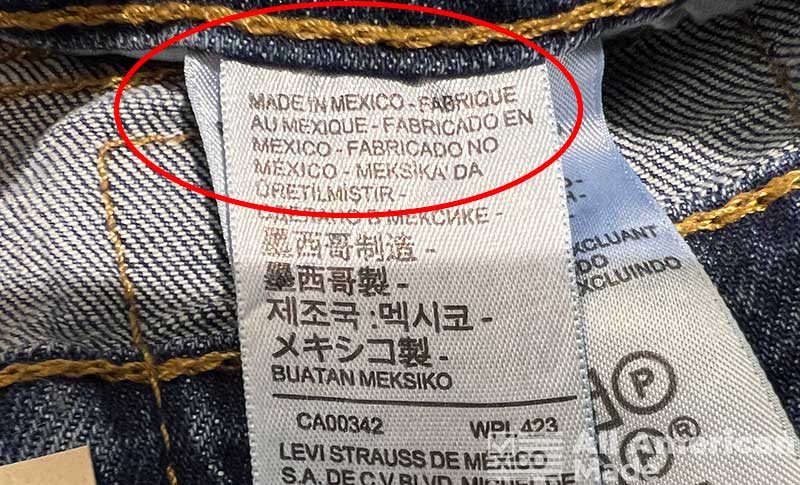
The fifth pair of Levi’s I checked was made in Egypt.
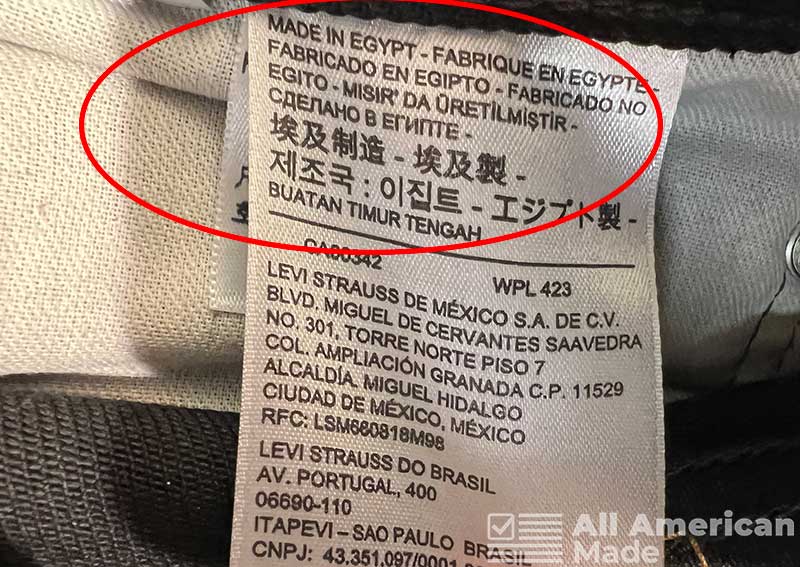
After checking about a dozen other jeans, I found that the majority were made in the countries mentioned above. It’s apparent that Levi’s jeans are made all over the world, but mostly in developing countries where the cost of manufacturing and labor is low.
Are Any Levi’s Jeans Made in the USA?
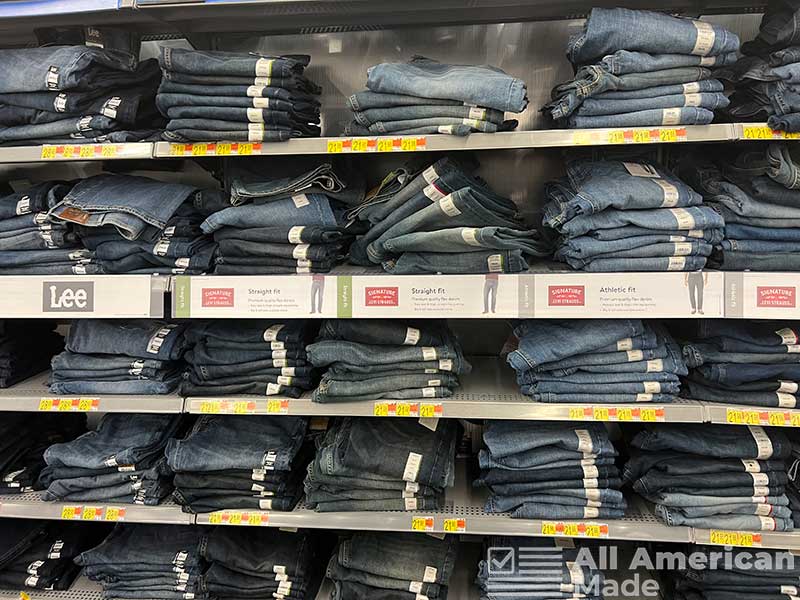
No, Levi jeans were once made in the USA, but they no longer offer any models that are made in the United States.
Levi Strauss jeans are not regarded as being made in the USA or manufactured in the United States with foreign and domestic components. They have been internationally outsourced, and there’s no confirmation from Levi Strauss if they plan to bring them back to domestic sourcing practices soon.
For a product to be assigned the distinction of being made in the USA or made in America, the product must be comprised of most, if not all American-made parts at an absolute minimum. This is dictated by the Federal Trade Commission via the Buy American act. Because of this, it is critical to do research prior to purchasing.
Products can claim that they are made in the USA but add in the caveat of “with foreign or domestic components.” This could indicate that your product will be comprised of multiple internationally sourced parts. While this can still leave you with a functional product, the higher-level concerns addressed above may not provide you with the most transparent buying experience.
This also releases them of any of the responsibility of false advertising while getting the marketing benefit of selling products that begin with the phrase “made in the USA”. This further highlights the need for extensive research prior to making your purchase to ensure that you are making the most informed choice possible.
With this in mind, Levi’s jeans do not satisfy any of the requirements to label their jeans as made in the USA in any way.
Popular Related Article: Where Are Wrangler Jeans Made?
When Did Levi’s Jeans Stop Being Made in the USA?
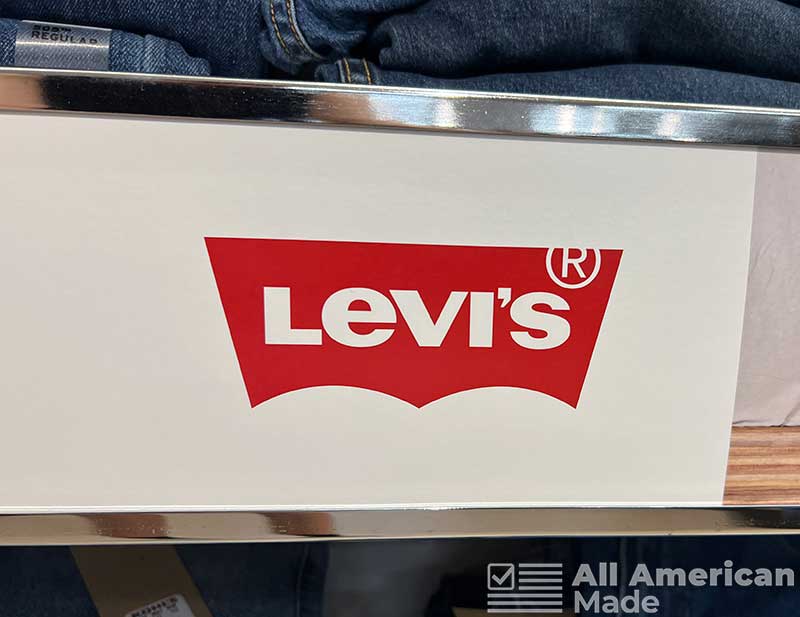
The last factory that manufactured Levi jeans in the United States closed in 2003.
Let’s talk more about how the manufacturing of Levi jeans has changed over time below.
Levi Strauss became an international company in the 1960s, opening its first auxiliary locations in Europe and other global hotspots in 1965. With this in mind, Levi’s began originally as an American-based company and sourced the original products for the dry goods business domestically way back in the 1800s at its inception.
Looking forward to the 1980s, the company rapidly expanded under the economic boom that was rippling through the national economy under President Reagan. There were several popular manufacturing plants throughout the United States, and Levi’s jeans were one of the top clothing options of that era.
Over the next two decades, Levi’s would slowly begin to outsource, opting for cheaper manufacturing prices and quicker turnaround times overseas. One by one, the famous factories began to close their doors. The final factory closed in San Antonio, Texas, in 2003.
While the manufacturing and formation process was taken overseas, Levi’s worked hard to maintain a formidable presence in the US buying market, painting themselves through targeted marketing techniques as an American necessity.
Throughout this time, Levi’s continued to launch additional lines, initiatives, and products. Some of the most notable of these include lines of men’s and women’s formal and casual shirts and tops, work boots, different cuts of jean pants, and jackets. They continued to outsource for these lines and eventually found themselves in some of the most influential department stores and big-box retailers in America. Some of the most notable of these stores included Kohl’s, Macy’s, and JCPenney.
Many struggled with determining purchasing options after the last factory closed in 2003. There was the inevitable conflict, as America would soon be heading into a recession. The dollar behind individual purchasing power mattered now more than ever, and consumers were looking for new ways to pour jobs and financial capital back into our domestic economy.
Further on in the decade, Levi’s chose to pivot back to tradition. They decided to launch a small iteration and line that they dubbed the “501st,” which was sourced from denim mills along the East Coast, bringing forth a revolutionary piece of clothing to the fashion industry.
Speculation did remain if all material elements were truly sourced from American sources, and the line was shortly discontinued after the page was removed from Levi’s site. Fans assume that they were domestically manufactured due to the drastically higher price point compared to the average Levi’s jeans product.
However, Levi’s has worked throughout its tenure to make a true difference in the global stage of fashion. If you are making the purchase to buy American-made products based on broader ethical and environmental concerns, you might consider Levi’s initiatives in their Water<Less initiative and global Worker Well-Being programs.
Both of these efforts were among the first of their kind and solidified Levi Strauss as a global ambassador to the wider field of fashion. Both of these efforts were launched in 2016, as Levi’s strove to make a larger-scale difference and disrupt the current standards of the global industry.
According to an official statement from Levi’s, products under the Water<Less initiative were created far more responsibly with the local ecology in mind. They claim that these conservatory practices helped save the product manufacturing process’ consumption of water by an average of 29% and as much as 96% for select Levi Strauss products.
Additionally, the Worker Well-Being program sought to address disparities in the global arena of fashion development. Fast fashion was continuing to take a toll on the health and well-being of millions of workers around the globe, especially those in underserved areas.
This global initiative sought to give those workers a voice and encouraged transparent worker experience reporting in countless businesses in the industry. Levi envisioned a world where equality was encouraged and fair practices became the standard, leading to the launch of the aforementioned Worker Well-Being program framework.
To fully understand the value that Levi’s brought to the United States, we first have to go back in history to the very start of Levi’s revolution.
Levi’s was created by Levi Straus, an immigrant to the United States who came from a background in the dry goods business and shipment. He came from a family of businessmen and wanted to try his luck in the Gold Rush towns in the American Wild West. He founded his business in 1853 in San Francisco, CA. This store catered to the town’s dry goods needs long before anyone even dreamed of denim.
The very concept of Levi’s began thanks to a patent secured in 1873 for a new way to fasten pockets. The men at the time were working hard in the mine systems and the fields, and the common cotton pants were unreliable enough to withstand the workday.
The solution that Strauss came up with was simple, sturdy, and well-crafted work pants that would withstand the stressors on the fabric, with a premiere design for button fastening. This would help keep any important items from falling out during the workday.
The design came together, and Levi’s jeans were born.
Levi’s Jeans wouldn’t stop there, they continued to make history by launching the first jean pant for women in 1934. The brand would grow to be a global name by the end of 1965, launching auxiliary plants and offices in Europe and Asia.
If you’d like to learn more about the history of Levi Jeans, check out the documentary below:
Who Owns Levis?
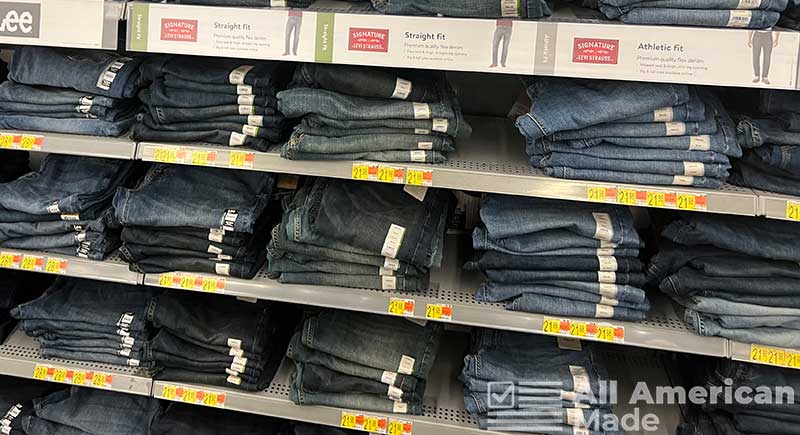
Levis was a privately held company owned by the descendants of the Haas family. In 2019 the company went public for a second time. According to a report by the SEC, six members of the Haas family combined own 64% of Levi Straus shares.
Besides the Haas family, here are the top 3 stock owners of Levi Strauss & Co as quoted from a CNN Business piece on the top 10 shareholders of Levi.
| Stockholder | Stake |
| The Vanguard Group, Inc. | 7.75% |
| Parnassus Investments | 5.63% |
| Wellington Management Co. LLP | 5.48% |
Levi’s CEO:
Joining the brand in 2011, the current Levi Strauss & Co CEO is New York-born and Lafayette College graduate Charles V. Bergh, he’s also known as Chip Bergh. Besides being the brand’s president and chief executive officer, he’s also on the company’s board of directors.
Bergh’s arrival to Levis Strauss marked a different and more direct focus on sustainability as well as an increased engagement in efforts to connect to a millennial and Gen-Z appeal.
Are Levis 501 Made in the USA?
There may have been a few pieces left in stock back in 2019 of the American-made 501 jeans, but the iconic garment is no longer being sourced or produced in the United States.
Cemented as Time Magazine’s “fashion item of the 20th century”, he 501 dates back to the wake of the California Gold Rush back in 1873. The closure of Cone Mills’ White Oak plant in 2017 forced the company to look for a replacement before deciding to switch to Kaihara Mills in the spring of 2019, but the American-made 501’s production was already in decline.
Alternative Jean Options Made in the USA
While Levi Strauss Jean Co products are no longer made in America, we can only hope that they will return to domestic manufacturing practices. If you are in the market for jeans that are American-made with unbeatable quality and a buttery-soft feel, you don’t have to look much further. Below, we’ve listed some of the most enviable jean manufacturers that provide high-quality products at affordable prices. The best part? Each and every item from these vendors is 100% and proudly made in America.
American Giant: American Giant was founded with the mission of bringing quality back to the American fashion scene. Bayard Winthrop was experiencing constant dissatisfaction with the quality of current clothing options. He did what any entrepreneur would do, do it himself. American Giant has a wide variety and multiple lines for both men and women. Their company’s focus embraces simplicity and directly combats the concept of fast fashion.
Dearborn Denim: Dearborn Denim entered the scene recently, 2016. They proudly provide comfortable, affordable, and quality-based American-made jean options for both men and women. They focus on creating options with the lowest possible price tag while keeping working wages fair and livable for employees. If you’re looking for an affordable jean option, look no further than Dearborn Denim.
If you’re looking to purchase an all-American made pair of jeans, we have an excellent article on our favorite jeans made in the USA.
Wrap Up:
That does it for this article. If you own a pair of Levi’s that you bought recently, comment below where they are made so everyone else can know! If you have any questions regarding where Levi jeans are made, let us know in the comments below.
Hi, my name is Kevin and I’m from Pittsburgh, Pennsylvania. Choosing products made in America is important to me because it supports local economies, creates jobs, helps the environment, and ensures ethical labor practices. I also find that American made products are usually of higher quality so although they’re a little more expensive, you save money in the long run. Before starting this website I was in the USMC infantry and nowadays I work on this website as a hobby.

Love my Levis, but the ones I own are very old so they probably are made in the US. Sad to see that I may no longer be able to get a new pair of my favorite jeans that are of similar quality. Anyway, thanks for the info I won’t be mad at the messenger!
Hey Kailey, I’ve had multiple people tell me that old Levis were great. Sadly we’ll have to find alternatives now.